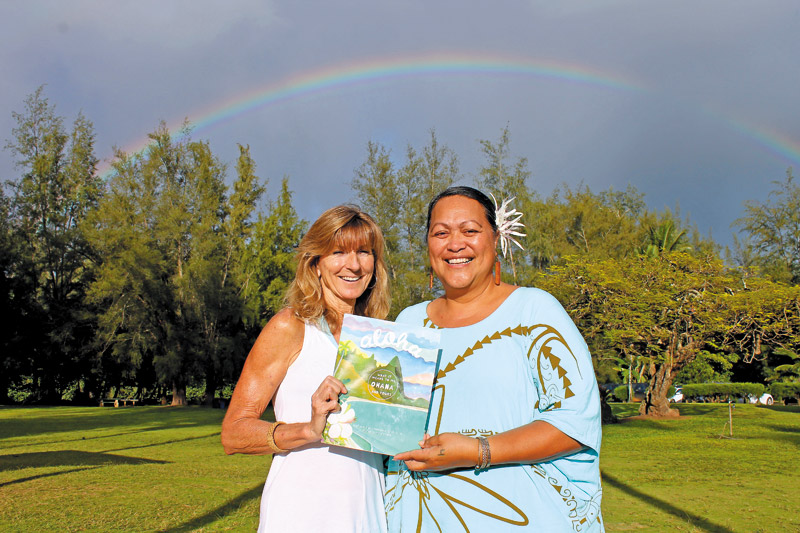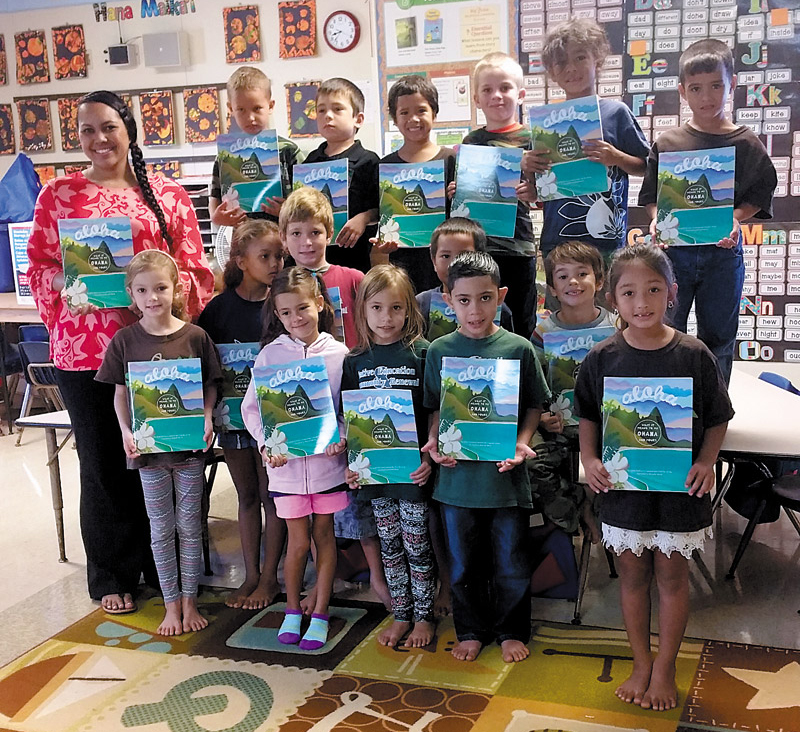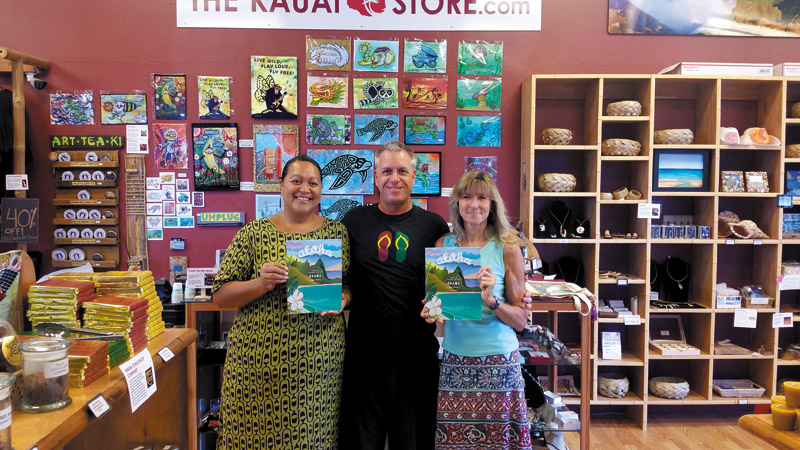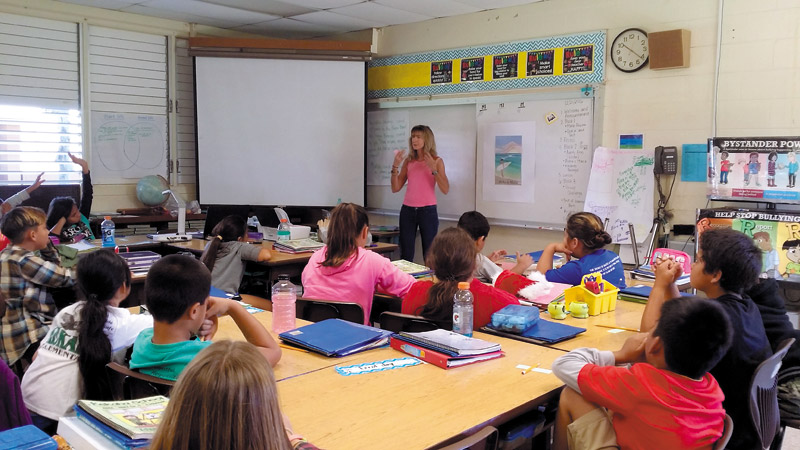Defining Aloha

Ann Hettinger (left) and Lahela Keikila‘au‘o‘wakanahele Chandler Correa with their new book, ‘Aloha’ COCO ZICKOS PHOTO
Lahela Keikila‘au‘o‘wakanahele Chandler Correa was stuck behind slow-moving traffic crossing one-lane bridges in Haena on her way to a recent interview with Kauai Midweek. But even though she was on the brink of losing her cool, she remembered to tap into an inherent part of her culture and instead radiated aloha.
“She exudes aloha and she’s taught me a lot; she’s softened my heart,” says Ann Hettinger before Correa arrived at Black Pot Beach for the interview.
Not only has Correa made it part of her job to share the many meanings of aloha during tours she leads at National Tropical Botanical Garden’s Limahuli Garden and Preserve, but she also brings the message to others with a book she co-authored with Hettinger, Aloha: What it Means to My Ohana and Yours.

Mele Cachero and her first-grade class at Kanuikapono Charter School in Anahola with their ‘Aloha’ books
The two met several years ago when Hettinger would bring her women’s retreat groups, Soul and Sport Adventures, to the North Shore garden for tours.
“They need to have a little bit of a feel for the culture,” explains Hettinger. “It’s great to come here, but you need to appreciate why you’re here and who are the people.”
When Correa would routinely share “aloha” with the visitors, Hettinger says, “There was not a dry eye.”
The duo quickly became friends and Correa, born and raised in Wainiha, served as a mentor to Hettinger.
“Even though you live here, it doesn’t really mean you know what aloha is and can fully appreciate what it is,” says Hettinger.
Over time Hettinger suggested sharing Correa’s sage advice in a book. The rest is history.
The book, which was released August 2016, dives into Hawaiian culture and the essence of aloha. Although largely meant for keiki, it has a universal message that extends to people of all ages, with several interactive features such as puzzles that help readers learn how to live a life of aloha.
When Correa finally arrived for the interview, though she explained how flustered she was from her journey, it was almost impossible to tell. She emanates a sort of calm that’s indescribable, and she doesn’t forget to greet everyone with a great, big bear hug that you don’t want to let go of.
This aloha is something intrinsic she credits to her Hawaiian roots. Correa grew up in a large family with 15 siblings; she’s an expert on how to share, as well as get along with and care for other people. They lived what she calls a sustainable “fisherman lifestyle,” where men and women throw net “old style.” She still practices this method, and also continues to cultivate her family’s 5-acre taro farm. She acknowledges learning the most from her mother, Kapeka Chandler, who was always loving and giving, and her father, Francis Elias Chandler Sr., for demonstrating structure, discipline and respect — all values which are included in the book.

Correa (left) and Hettinger at one of their retail outlets, The Kauai Store in Kapaa, with owner Erik Vurton
“Lahela and I are from two different worlds,” says Hettinger, a Colorado native, who feels lucky to have the opportunity to team up with someone with such cultural wisdom.
Their differences, however, don’t mean much when it comes to the message they are sharing. And that’s exactly the point. They want children and adults to read the book and forget about their differences and embrace everyone, letting go of the barriers that cause stress and strife.
“The world needs more aloha right now,” says Hettinger, who developed Aloha Publishing Hawaii in order to produce the book, as well as the nonprofit Aloha Movement Kauai to help raise funds to distribute books to schools.
There’s little doubt that Aloha: What it Means to My Ohana and Yours has come at a valuable time, especially as more people become disconnected because of technology and other elements, like political strain. In fact, it’s already been distributed to classrooms at Hanalei and Kekaha elementary schools, where teachers are incorporating the lessons into their curriculum.
“This new partnership builds and supports the foundation of our Hawaiian values, language, culture and heritage to develop academic achievement, character, physical and social-emotional well-being of all our students to their fullest potential,” says Bill Arakaki, Kauai Complex Area superintendent.
Even visitors are loving Aloha, which recently was printed in Japanese.
“The thing is, most visitors have no idea what aloha really means,” says Hettinger. “This is definitely a way for them to gain a deeper appreciation of aloha and the Hawaiian culture.”
But it’s really about getting the message to children, including unconditional love.
“They’re the future. We know the adults need it, but the future is the kids,” says Hettinger. “This is more than a good thing.”
Call Hettinger at 651-8856 or email her at contact@alohapublishinghawaii.com to make a tax-deductible donation. The book is available at several locations around the island including Kauai Museum, Ace Hardware in Princeville and NTBG’s South Shore Visitors Center. Visit alohapublishinghawaii.com for more information.
cocomidweek@gmail.com





